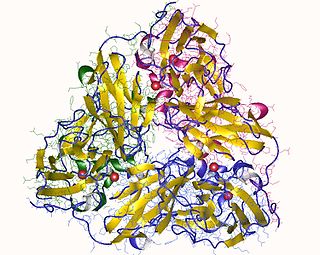Related Research Articles

The organic compound citrulline is an α-amino acid. Its name is derived from "citrullus", the Latin word for watermelon, from which it was first isolated in 1914 by Koga and Odake. It was finally identified by Wada in 1930. It has the formula H2NC(O)NH(CH2)3CH(NH2)CO2H. It is a key intermediate in the urea cycle, the pathway by which mammals excrete ammonia by converting it into urea. Citrulline is also produced as a byproduct of the enzymatic production of nitric oxide from the amino acid arginine, catalyzed by nitric oxide synthase.
BRENDA is an information system representing one of the most comprehensive enzyme repositories. It is an electronic resource that comprises molecular and biochemical information on enzymes that have been classified by the IUBMB. Every classified enzyme is characterized with respect to its catalyzed biochemical reaction. Kinetic properties of the corresponding reactants are described in detail. BRENDA contains enzyme-specific data manually extracted from primary scientific literature and additional data derived from automatic information retrieval methods such as text mining. It provides a web-based user interface that allows a convenient and sophisticated access to the data.
Microbial collagenase is an enzyme. This enzyme catalyses the following chemical reaction
Nylon-eating bacteria are a strain of Arthrobacter that can digest certain by-products of nylon 6 manufacture. This strain of Flavobacterium sp. K172, became popularly known as nylon-eating bacteria, and the enzymes used to digest the man-made molecules became popularly known as nylonase.
Leukotriene B4 (LTB4) is a leukotriene involved in inflammation. It has been shown to promote insulin resistance in obese mice.

Achromobacter is a genus of bacteria, included in the family Alcaligenaceae in the order Burkholderiales. The cells are Gram-negative straight rods and are motile by using one to 20 peritrichous flagella. They are strictly aerobic and are found in water and soils. They have also been identified as a contaminant in laboratory cell cultures. They have been identified as opportunistic human pathogens in people with certain immunosuppressive conditions such as cystic fibrosis, cancer and kidney failure.
Nitrate reductase (cytochrome) (EC 1.9.6.1, respiratory nitrate reductase, benzyl viologen-nitrate reductase) is an enzyme with systematic name ferrocytochrome:nitrate oxidoreductase. This enzyme catalises the following chemical reaction
In enzymology, an UDP-N-acetylglucosamine 6-dehydrogenase (EC 1.1.1.136) is an enzyme that catalyzes the chemical reaction
In enzymology, a phenylacetaldehyde dehydrogenase (EC 1.2.1.39) is an enzyme that catalyzes the chemical reaction
In enzymology, a 3-carboxyethylcatechol 2,3-dioxygenase (EC 1.13.11.16) is an enzyme that catalyzes the chemical reaction

In enzymology, a nitrite reductase (NO-forming) (EC 1.7.2.1) is an enzyme that catalyzes the chemical reaction

In enzymology, an aspartate 4-decarboxylase (EC 4.1.1.12) is an enzyme that catalyzes the chemical reaction
In enzymology, a 6-aminohexanoate-cyclic-dimer hydrolase (EC 3.5.2.12) is an enzyme that catalyzes the chemical reaction
In enzymology, a glycerol-3-phosphate O-acyltransferase is an enzyme that catalyzes the chemical reaction
In enzymology, a taurine-2-oxoglutarate transaminase is an enzyme that catalyzes the chemical reaction
Lysyl endopeptidase is an enzyme. This enzyme catalyses the following chemical reaction
Beta-lytic metalloendopeptidase is an enzyme. This enzyme catalyses the following chemical reaction
Achromobacter cycloclastes is a Gram-negative, aerobic bacterium from the genus Achromobacter. The complete genome of A. cycloclastes has been sequenced.
Achromobacter obae is a bacterium from the genus Achromobacter which contains the enzyme alpha-amino-epsilon-caprolactam racemase. The complete genome of A. obae has been sequenced.

Cytochrome P450-DIT2 or CYP56A1 is one of the only three P450 enzyme found in fungi baker's yeast, the other two are CYP51F1(ERG11) and CYP61A1(ERG5) in the ergosterol biosynthesis pathway. CYP56A1 thought to catalyze the oxidation of tyrosine residues in the formation of L,L-dityrosine a precursor of the spore wall.
References
| This Betaproteobacteria-related article is a stub. You can help Wikipedia by expanding it. |